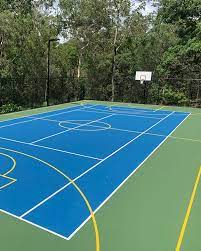Tennis, a sport with a rich history dating back centuries, has evolved significantly in terms of gameplay and infrastructure. Today, tennis courts are more than just surfaces for competition; they are critical components that impact gameplay, player safety, and overall aesthetics. This comprehensive guide will explain the science of tennis court resurfacing, exploring the materials and techniques that go into creating the perfect playing surface.
Understanding the Basics
Before we delve into the nitty-gritty of tennis court resurfacing services, let’s establish a fundamental understanding of tennis court types and their importance.
Types of Tennis Courts
Tennis courts come in various types, each with distinct characteristics:
Hard Courts: Hard courts are made of asphalt or concrete, covered with an acrylic layer. They offer a medium pace and consistent bounce, making them popular for professional tournaments like the US Open.
Clay Courts: Clay courts consist of crushed shale, stone, or brick. They provide a slower playing surface with high bounce and are favoured in Europe, particularly at the French Open.
Grass Courts: Grass courts, often associated with Wimbledon, offer a unique playing experience with low bounce and fast play. They require meticulous maintenance due to the natural grass surface.
Carpet Courts: Carpet courts are made of synthetic materials and are relatively fast-paced. They are often used for indoor play.
Artificial Grass Courts: These courts mimic the feel of natural grass but are more durable and low-maintenance.
Now, let’s shift our focus to the crux of this guide – the resurfacing process.
The Resurfacing Process
Tennis court resurfacing is a complex and meticulous process that involves several crucial steps to ensure a quality playing surface. Each step contributes to the longevity and performance of the court.
Surface Preparation
The first step in resurfacing a tennis court involves thorough surface preparation. It typically includes:
Cleaning: Removing all debris, dirt, and loose materials from the court’s surface.
Repairing Cracks: Filling and repairing any cracks or imperfections in the existing surface.
Levelling: Ensuring the court is perfectly level to avoid water accumulation.
Application of Binder
The binder is a crucial element in tennis court resurfacing, as it serves as the base layer for the new surface. Common binders include acrylic emulsion or latex.
Application of Cushioning
For hard courts, a cushioning layer is applied to enhance player comfort and reduce the impact on joints. This cushioning layer is often made of rubberized material and is an essential component for player safety.
The Playing Surface
The choice of surface material is one of the most critical decisions in resurfacing. The two primary options are:
Acrylic Surfacing: A popular choice for hard courts, acrylic surfaces provide a durable, non-slip, and customizable finish. They come in various colours, allowing for creativity in court design.
Synthetic Turf: For those looking to create a grass-like feel without the maintenance challenges of natural grass, synthetic turf is an excellent option. It offers consistent play and is low-maintenance.
Line Markings and Color Coating
Precise line markings are essential for tennis court functionality. The use of bold, contrasting colours ensures clear visibility of lines. The selection of colours can also impact the court’s aesthetics.
Post-Resurfacing Curing
Once the resurfacing is complete, the court needs adequate time to cure. Curing allows the materials to bond properly and ensures the longevity of the surface.
Choosing the Right Materials
Selecting suitable materials for tennis court resurfacing is a critical decision that directly impacts the quality and performance of the court. Here, we’ll explore some key material considerations.
Acrylic Coatings
Acrylic coatings are a popular choice for hard courts. They offer several advantages, including:
Durability: Acrylic surfaces can withstand heavy usage and adverse weather conditions, making them suitable for year-round play.
Customization: Acrylic coatings come in various colours, allowing for creative court design.
Non-Slip: These surfaces provide excellent grip and reduce the risk of player injuries.
Quick Drying: Acrylic coatings dry quickly after rain, minimizing downtime.
Cushioning Systems
For hard courts, cushioning systems are essential to reduce player fatigue and injury risk. Common cushioning materials include:
Rubberized Pads: These pads provide shock absorption and enhance player comfort.
Elastomeric Coatings: Elastomeric coatings are applied over the binder layer and provide a cushioned feel.
Line Markings
Clear and precise line markings are crucial for tennis court functionality. Consider using highly visible, durable paint or tape for line markings.
Synthetic Turf
Synthetic turf is an excellent alternative for those seeking the aesthetics of grass courts without the maintenance challenges. Key benefits include:
Low Maintenance: Synthetic turf requires minimal upkeep compared to natural grass.
Consistent Play: These surfaces offer consistent play throughout the year.
Durability: Synthetic turf is designed to withstand heavy use and adverse weather conditions.
Maintenance and Longevity
Proper maintenance is essential to extend the life of a resurfaced tennis court. Here are some tips for maintaining your tennis court:
Regular Cleaning: Sweep or blow debris off the court regularly to prevent surface damage.
Pressure Washing: Periodically pressure wash the court to remove dirt and algae buildup.
Crack Repair: Address any cracks or imperfections promptly to prevent them from worsening.
Recolouring: Over time, the court’s colours may fade. Consider recoating to maintain its vibrant appearance.
Resurfacing: Eventually, even well-maintained courts will require resurfacing. Plan for this to ensure consistent play.
Conclusion
Tennis court resurfacing is a science that combines materials, techniques, and expertise to create a perfect playing surface. Whether you’re a professional tournament organizer, a tennis club owner, or a homeowner with a backyard court, understanding the intricacies of tennis court resurfacing Brisbane can help you make informed decisions that enhance the longevity, safety, and performance of your court. With the appropriate materials and techniques, you can create a tennis court that players of all levels will enjoy.
